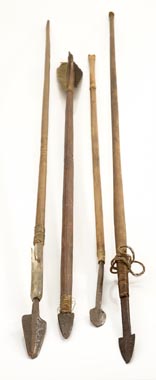
AB 520, arrow, Inuit, copper, wood, sinew, feathers, 78 cm x 4.3 cm, Collection of Glenbow Museum, Calgary, Canada. AB 375, arrow, Inuit, copper, bone, wood, sinew, 89.5 cm x 2 cm, Collection of Glenbow Museum, Calgary, Canada. AB 515 b, arrow, Inuit, copper, wood, sinew, feathers, 76 cm x 1.2 cm, Collection of Glenbow Museum, Calgary, Canada. AB 294, arrow, Inuit, wood, steel, linen, 93 cm x 1.5 cm, Collection of Glenbow Museum, Calgary, Canada.
Inuit arrows- spear set
Inuit arrows- spear set.
Evidence
This sealskin pouch is designed with quick hitch fasteners. It would have been waterproof and therefore good for carrying materials for fire lighting. These types of spears were designed to be propelled. They would have travelled a good distance depending on the skill of the thrower.
Perspective
A seal that has been wounded will come up out of the stinging salt water. The noose-style spear worked well with seals who are on the ice.
Significance
Hunters always carried a small stove made of soapstone called a quliq. With this, they would have had wick materials such as Arctic cotton or moss and a flint to create a spark or small bow drill to create heat. On short trips special containers carried live embers for quick fire starts. The first spear was propelled like a sling shot. A rope with a noose was attached to the hook on the shaft. It would have been used at close range for land animals. The second spear would have been shot from a crossbow. The third spear would have been launched using a bow and the fourth is a hand spear used from a lying position.